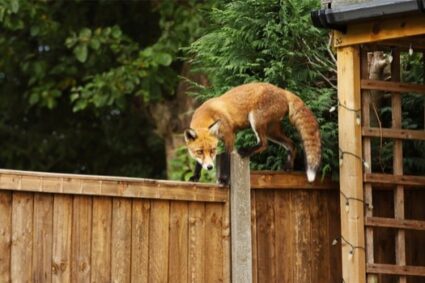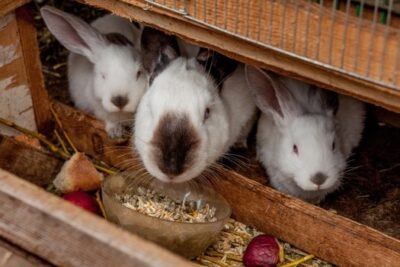Rabbits are prey animals. Many wild animals hunt rabbits, including foxes, hawks, cats, dogs, and raccoons. If your pet rabbit lives outdoors, you need to ensure that you keep your rabbit safe from predators.
Build your rabbit a predator-proof hutch made from solid wood with strong wire mesh and sturdy bolts. Outdoor runs should be covered to prevent hawk attacks with a floor to stop foxes digging underneath. Use motion-activated lights and sprinklers to scare predators away.
We’re going to look at what types of predators hunt rabbits and how to keep your pet safe outside. We’ll explain how to build a predator-proof rabbit hutch and share advice on how to repel predatory animals from your yard.
What Kills Rabbits at Night?
All animals need to eat to live. While rabbits are herbivores, not all animals can survive on grass. Many animals hunt and eat other animals, including rabbits.
North America has many predators. Sadly, rabbits are the natural prey of most of them. While they are most common in the wild, some predators live and hunt in towns and cities, too.
Predators don’t distinguish between wild and domesticated rabbits. Food is food, regardless of where it comes from. If your rabbit lives outside, they’re easy targets for all sorts of wild animals.
Some domesticated animals also hunt rabbits. Unless your neighbors are vigilant about keeping their pets indoors, they could be a threat to your bunny.
Certain predators hunt rabbits at night, while others are active in the day time. The most common rabbit predators include:
- Foxes. They hunt at night and sleep in the daytime.
- Cats, including pet cats and bobcats. They can hunt at night or during the day.
- Dogs, wolves, and coyotes. These opportunistic feeders can hunt at any time.
- Raccoons and badgers, which are nocturnal and hunt at night.
- Birds of prey, such as hawks, falcons, kestrels, and owls. Some are nocturnal whereas others are diurnal (active in the day).
- Weasels and stoats. They are nocturnal during the winter, but diurnal in the warmer months.
- Large snakes, such as gopher snakes and some rattlesnakes. Depending on the species, they may hunt at any time of day.
Most of these predators will seize any opportunity to attack an unprotected rabbit. Depending on where you live, the specific predators in your area may vary.
What Kills Rabbits in the Wild?
The same kinds of predators that pose a threat to domestic rabbits also hunt wild rabbits. Although wild rabbits and domestic rabbits are different species, they are both equally tempting to predators.
However, wild rabbits don’t always die from predator attacks. They’re quite good at avoiding being caught. Instead, many wild rabbits die from other causes.
For example, many rabbits die from poisoning. Rabbits don’t have much innate knowledge of which plants are bad for them. They can also die from consuming plants treated with pesticides.
Disease, injury, and parasites also claim their fair share of rabbits’ lives, as do adverse weather conditions. Rabbits can survive in the cold reasonably well, but they die quickly in the heat.
How Do Rabbits Protect Themselves from Predators?
You may be wondering whether rabbits can defend themselves at all. After all, if they couldn’t, how would they ever survive in the wild?
Rabbits do have limited defensive strategies, but they can’t fight predators off. They rely on trying to keep away from predators in the first place.
Domestic rabbits are descended from European wild rabbits. They dig huge, complex warrens in the ground, which is where they spend most of their time. They come out to forage at dawn and dusk, when they are less visible to predators.
With powerful senses, rabbits can smell and hear predators coming from far away. They are also exceptionally fast. When they sense danger, they thump their feet to warn nearby rabbits, and run back to the warren.
According to the Journal of Comparative Physiology, as a last resort, rabbits freeze completely. This is called tonic immobility. It helps them to hide from predators that are close by.
American wild rabbits are unrelated to European rabbits. The most common variety is the cottontail.
Cottontails don’t burrow in the ground, like European rabbits do. When a predator is nearby, they will flee and seek any natural shelter that they can find. They will then stay perfectly still, and hope the predator doesn’t spot them.
As rabbits rely on their speed to escape predators, it’s easy to see why our pet rabbits are vulnerable. Living in a hutch or exercise pen, there’s nowhere for them to run when a predator appears.
A rabbit will rarely play dead to avoid predators. Most animals that eat rabbits are scavengers.
How to Protect Rabbits from Foxes
If your rabbit lives outside, predators should be your main concern, along with providing protection from the weather.
The most common predators that you’ll encounter will be foxes and raccoons. They live in urban areas as well as rural ones, and will hunt anything small enough.
However, the following tips will work for any land-based predator.
Keep Your Rabbit Indoors
The most effective way to ensure your rabbit’s safety is to house them indoors.
It’s a common misconception that pet rabbits have to have access to the outside. Though wild rabbits may run around fields, pet rabbits get on just fine living inside homes.
It doesn’t matter whether you live in a small apartment or a large house. As long as they’ve got food, water, toys and enough space to play, they’ll be happy. Bunnies can be litter box trained, and it’s easy to rabbit-proof a room.
If you can’t keep your rabbit inside, a large garden shed is the next best thing. As long as it’s sturdy, predators shouldn’t be able to get in. You can let your rabbit outside while supervised, in a covered run.
Predator-Proof Your Rabbit’s Hutch
If your rabbit can’t live indoors, you’ll have to ensure that your rabbit’s hutch is sturdy enough.
Unfortunately, the kinds of cages and hutches that pet stores sell are usually unsuitable. They’re often made from cheap plywood or chicken wire, which don’t hold up well to a determined fox. The latches are often simple enough for raccoons to open.
Mass-produced rabbit runs and pens are also not much use outdoors. They typically do not have a roof or a floor. Foxes can jump and climb, and they can also dig underneath fences.
To protect your rabbit, you should make your own predator-proof hutch. We’ll discuss how to do this further on.

Make Your Yard Unappealing to Predators
If your rabbit’s hutch is predator-proof, this solves the biggest problem. It stops predators from being able to reach your rabbit.
However, rabbits can also die of shock. Although it’s rare, it is possible for rabbits to become so frightened that they have a cardiac arrest.
This can happen in response to anything frightening such as loud noises. An article in BBC News reported that five rabbits died when firecrackers were let off near their home.
Rabbits can also die when confronted by a predator, even if the predator can’t touch them. For this reason, you should try to make your yard as unattractive as possible for predators.
Keep your yard tidy and the grass cut short. Cover or get rid of any standing water that might attract animals to drink. Keep your yard free of food scraps, and keep tight lids on trash cans.
Motion-detecting lights can also help to deter nocturnal creatures like foxes.
Never Let Your Rabbit Outside Unsupervised
If your rabbit has a fully predator-proof enclosure, it should be safe to leave them alone inside it. You should check on your bunny at least every few hours. If possible, bring your rabbit inside to spend time in the home while you’re awake.
It’s never a good idea to let your rabbit out to explore the yard, with no shelter. If you do, stay with them and supervise them at all times. Predators such as foxes are usually scared of humans, and won’t approach if you’re around.
Furthermore, rabbits can fit into the tiniest gaps in fencing and bushes. They can easily escape the yard if you don’t have your eye on them.
How to Protect Rabbits from Hawks
As long as your rabbit’s hutch is fox-proof, it should also be safe from birds of prey, such as hawks.
However, there are other aspects that you have to consider when protecting your rabbit from aerial predators.
Unlike foxes, hawks and other birds of prey are not always afraid of humans. Even if you’re out in the yard with your rabbit, this may not deter them.
A hawk could swoop down and snatch up your rabbit right in front of your eyes. So, never let your rabbit out in the open or in an uncovered run.

Your rabbit’s run or exercise pen must have a roof, made of wood paneling or a sturdy wire mesh. That way, if a hawk does notice your rabbit, they won’t be able to reach it.
As hawks hunt from above, unpleasant scents don’t deter them. However, shiny, reflective objects work wonders. Birds become easily disoriented when light is being reflected in their eyes.
An easy way of achieving this is to hang old, unwanted CDs in your yard. You can tie them to tree branches, bushes, and fences. As the light hits the hawk’s eyes, it will confuse and distract them, deterring them from landing.
Do Scarecrows Scare Hawks?
Scarecrows are large, life-sized decoys built in the shape of a human. They are used in farmer’s fields, for scaring crows and other birds away from sown seed and crops.
It’s possible that scarecrows may work to deter some birds of prey from coming near your rabbits. However, some birds of prey aren’t put off by humans. They are intelligent, and not easily fooled by tricks.
Depending on which birds of prey are in your area, scarecrows may or may not work. You can also try using a lifelike owl statue, as hawks are afraid of owls.
Whichever decoy you use, move it to a different place in your yard every few days. Hawks and kestrels will soon realize it’s not real if it never moves.
Use decoys in combination with other methods. This will ensure your rabbit is safe, even if one method doesn’t work.
How to Build a Predator Safe Rabbit Hutch
The only way to keep your rabbit completely safe from predators is to house your rabbit indoors. If this isn’t practical, you’ll need to build your rabbit a predator-safe hutch and run.
Some predators can fly, and others can dig. So you’ll need to make sure that the hutch is impenetrable from the side, above, and underneath. You will need to use:
- Solid wood for the sides, roof and floor of the hutch. Pine is a good choice. Make sure the joins are secure.
- Heavy-duty chain link or wire mesh for the see-through side of the hutch. Don’t use chicken-wire as this isn’t durable enough.
- Sturdy bolts for the gate or door. Simple latches aren’t good enough, as some animals are smart enough to figure them out. Assume that if a child could unlock it, so could a predator.
The size of the hutch should be at least 6ft x 2ft x 2ft. Raise the hutch off the ground on wooden legs to further repel predators. Give your rabbit at least one secluded area with solid wood walls so that they can hide.
The outdoor run or pen should measure 8ft x 4ft x 2ft. It should be covered with a chain-link roof, to protect from aerial predators. It will also need a floor, to prevent predators from digging underneath.
You can use wooden boards or wire mesh for the floor of the run. If using wire mesh, cover it with tile or bury it in the earth. Rabbits don’t like walking on wire as it’s uncomfortable.
Alternatively, bypass this step by placing the run on concrete, which predators can’t dig through.
How to Keep Dogs Away from Rabbit Hutch
Dogs are related to wolves and coyotes. They are natural predators, and to most dogs, a rabbit will look like a tasty snack.
Some dogs, such as terriers, were bred to hunt small mammals. But any dog of any breed has the potential to kill or injure a rabbit.

The best way to keep dogs away from your rabbit is to keep them out of your yard. Erect a high perimeter fence, made from solid-panel wood so that it isn’t climbable.
6.5 feet should be high enough to keep out most dogs. However, some dogs will dig underneath fences. Burying chicken wire at the base of the fence can solve this.
Build a predator-proof rabbit cage as detailed above. Then, even if there’s a dog in your yard, they won’t be able to access your rabbit.
Some dogs don’t like the smell of vinegar. Try spraying undiluted vinegar around the perimeter of your yard, and outside the rabbit’s hutch. Reapply it every day so that it doesn’t fade.
If you own a dog, never let them into the yard unsupervised. Keep them on a leash and away from your rabbit’s area.
Remember that rabbits can die of fright. Barking and aggression could be fatal on its own, without the dog having to touch your rabbit. Keeping your rabbit indoors is the best solution.
How to Train a Dog Not to Kill Rabbits
Not all dogs will instinctively kill rabbits. However, most will. You should never let your dog around your rabbit if they are untrained.
It is possible to train most dogs to leave rabbits alone. Your dog must be intelligent and willing to learn. Teaching a puppy or younger dog is usually more successful than an adult.
Teach your dog the “leave it” and “heel” commands. Once your dog can leave something alone on command, and return to your side, you’re ready to begin.
Practice with a realistic stuffed rabbit initially. Rub it in your rabbit’s litter box to give it an accurate scent. Place it in the room, and encourage your dog to leave the toy alone by redirecting their attention.
If your dog approaches the toy, tell them to leave it and heel. Praise your dog for responding to your commands.
When they have mastered this, you can introduce your real rabbit. Keep your rabbit in a cage until your dog is used to them.
Never leave your dog and rabbit together unsupervised, even when fully trained. When you’re not around, their hunting instinct may be too difficult to overcome.
How to Keep Cats Away from Rabbits
Cats are also likely to see your rabbit as food. Rabbits are prey animals, and cats are predators. By their nature, cats are hard-wired to hunt anything small and furry (or feathered).
Birds, mice, rats, guinea pigs and rabbits are all fair game to a cat. They also hunt for sport, so keeping your cat well-fed won’t deter them from attacking.
Some cats do get along well with rabbits. However, it’s the exception, rather than the rule. We would never recommend getting a pet rabbit if you have a cat, or vice versa.
However, your neighbors may also have cats that come onto your property. Here are our top tips for keeping cats away from rabbits:
- Cat proof fences. These have rollers at the top that spin if a cat tries to climb over them. You can also buy sharp spikes to place along the top of your fence.
- Cat repellent. Cats hate the smell of citrus. Place fresh lemon and orange peels around your yard. You can also buy ultrasonic “cat alarms” that emit a high-frequency noise which cats hate.
- Motion-activated sprinklers. Cats hate coming into contact with water. If they get sprayed in the face once or twice, they’ll soon avoid your yard altogether.
- Cat proof rabbit cage. Follow our above advice for building a predator-safe rabbit enclosure. That way, even if you can’t repel cats from your yard, your rabbit will be safe.
Use a combination of techniques for the best results. Cats are intelligent and, if determined enough, will exploit any loophole that they can find.
Can Rabbits Defend Themselves Against Cats?
Rabbits may have sharp teeth and claws, but this doesn’t mean that they can defend themselves. They mostly use their teeth and claws for chewing and digging.
A rabbit’s main defensive power is its speed. Rabbits are exceptionally fast, and when confronted by a predator, their first instinct is to run away. But pet rabbits can’t do this, as they’re confined to a cage, pen or room, with no way out.
Furthermore, domesticated rabbits often freeze when confronted by a predator. This is where the expression “like a rabbit in the headlights” originates. They become so nervous that they stop moving, making them even more vulnerable.
Rabbits may use their teeth and claws in self-defense as a last resort. However, they’re no match for a cat, fox, coyote, or any other predator. It’s your responsibility to ensure that your rabbit is well-protected from all potential threats.
If you can’t safeguard your rabbit’s outdoor enclosure, you should consider moving them indoors. Rabbits can be litter box trained, so there’s no reason not to. Just make sure to rabbit-proof your house before bunny moves in.


I have a problem with raccoons, stray cats, brown rats and my grandpa’s dog. I showed the dog what I was capable of and I would strictly tell him “NO!” or calm him down when he barked at my pet rabbit(s). But the mangy strays, nasty rodents and masked trash bandits are still a problem staring intently at the hutch or lying on it. Should I shoot them with my toy or scare them away? It has worked before.
This is so helpful! Thanks for all the tips to protect the adorable bunnies hopping around.
what predator takes the heads off just the heads and leaves the rest of the carcus